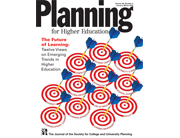The Future of Learning: 12 Views on Emerging Trends in Higher Education — from Planning for Higher Education by William J. Flynn and Jeff Vredevoogd
On behalf of our campuses, we need to seek out change; to be more flexible, more thoughtful, and more open to student decision making; and to build outcomes measurement feedback into integrated planning.
Note: In 2005, Herman Miller, Inc., a Zeeland, Michigan-based furniture manufacturer, convened a series of leadership roundtables in an attempt to predict what trends would affect higher education in the year 2015. Representatives from research universities, state colleges, community colleges, private institutions, and architectural and design firms participated in exercises designed to brainstorm about the future. Their collective thoughts were combined into a list of 12 predictions, which were revised in 2009 to reflect the current global economic situation. (Below emphasis by DSC).
- Globalization will influence and shape all aspects of teaching and learning.
- The wide range of ability, preparedness, background, opportunity, and motivation of higher education students will require more varied and holistic approaches to inclusive learning.
- The demand for more experiential, outside learning opportunities will require faculty to respond thoughtfully and proactively.
- Colleges and universities will be expected to deliver more education in less space—to increase their learning per square foot.
- Advancements in technology will drive ongoing changes in all aspects of college and university life and offer new opportunities to enhance and broaden learning experiences.
- Interdisciplinary learning will become increasingly common and popular.
- Students will take much greater control of their own learning as proactive producers and managers of their own learning solutions, materials, and portfolios. (From DSC: Speaks to the need for — and actual occurrence of — ever-changing learning ecosystems.)
- The average age of students will continue to rise; the mix of cultures, ages, and learning styles will become increasingly varied and rich.
- Competition for students and resources will force colleges and universities to sharpen their brands and identities and to distinguish themselves in new ways.
- Colleges and universities will become increasingly important parts of regional economic development, both in creating growth and taking advantage of it.
- The structures of educational institutions and the types of employment relationships between them and faculty will continue to multiply; inequities among faculty will cause tensions.
- Accountability and assessment tools will continue to become common in defining institutional effectiveness.
“Each of these 12 predictions provides both a challenge and an opportunity for colleges and universities. Scanning the horizon for future trends that could impact the educational enterprise is a wise expenditure of institutional time and energy, assuring a strong, resilient, and vibrant academy for future generations.”
William J. Flynn and Jeff Vredevoogd. 2010. The Future of Learning: 12 Views on Emerging Trends in Higher Education . Planning for Higher Education. 38(2): 5–10.









